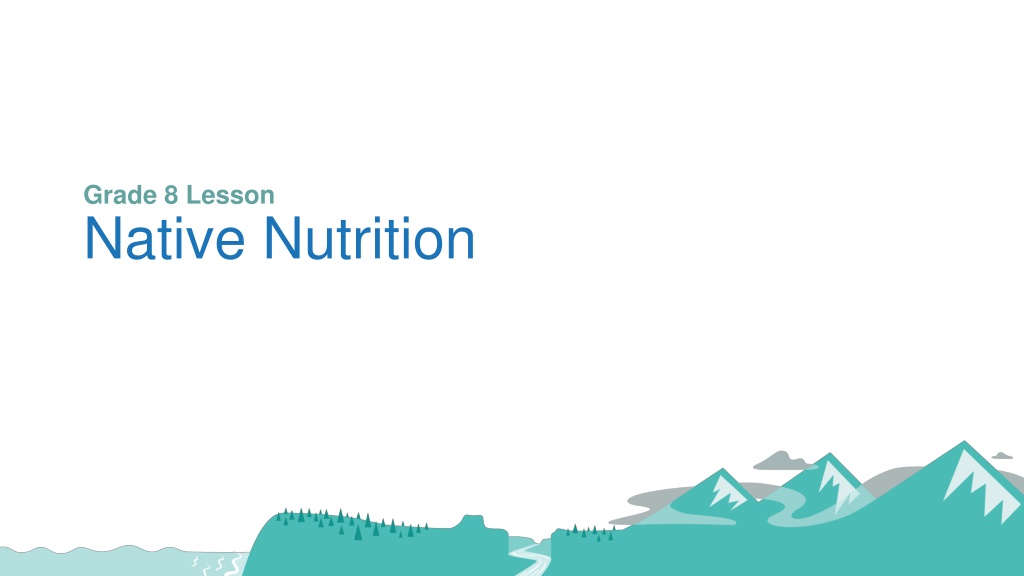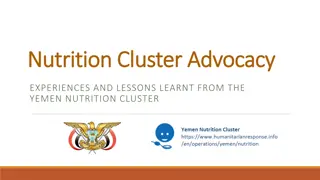Native Nutrition and Energy Balance: A Comprehensive Guide for Grade 8
Explore essential nutrients, energy sources, energy uses, and health risks related to nutrition and physical activity in this comprehensive guide for Grade 8 students. Learn about the importance of a balanced diet, different food sources of nutrients, and the impact of nutrition on overall health and well-being. Discover how energy is used by the body, the concept of energy balance, and the health risks associated with inadequate nutrition and physical activity.
Download Presentation

Please find below an Image/Link to download the presentation.
The content on the website is provided AS IS for your information and personal use only. It may not be sold, licensed, or shared on other websites without obtaining consent from the author. Download presentation by click this link. If you encounter any issues during the download, it is possible that the publisher has removed the file from their server.
E N D
Presentation Transcript
Grade 8 Lesson Native Nutrition
Essential Nutrients Nutrient How the Body Uses It Food Sources Notes Build and repair tissue Fight infections Energy source Seafood Lean meat and poultry Eggs Beans and peas Nuts and seeds Dairy products Soy products Protein Energy source Fiber source Fruit Vegetables Dairy products Grains (whole and refined) Soda and candy Consist of sugars, starches, and cellulose. Carbohydrates can be simple (easily digested) and complex (take longer to digest); complex are generally healthier Carbohydrates Energy source Help absorb vitamins Meats Poultry Seafood Eggs Seeds and nuts Avocados Cooking oil Fats can be saturated or unsaturated or trans fat; unsaturated is generally healthiest Fats
Energy Uses Uses Definition How Used Energy needed to digest food Eating and digesting food Thermic effect of food Energy used at rest Heartbeat, breathing, thinking, cell division Basal metabolism Energy used to perform any body movement Sitting, standing, turning your head, raising your hand, walking, running, playing a sport, exercising Physical activity Sources: U.S. Department of Health and Human Services, National Institutes of Health
Energy Balance Image Sources: https://medium.com/@decker_st/cico-energy-balance-68a5bda0327e, http://www.hollandclinic.com/science-of-weight-loss/nutrition/calories/energy-balance;
Health Risks - Not Enough Healthy Food Fatigue/low energy Get sick easily Failure to thrive (children) Diseases of malnutrition (e.g., scurvy, rickets, beriberi) Image Sources: Pixabay, Wikimedia Commons
Health Risks - Not Enough Activity Heart Disease High blood pressure Stroke Obesity Diabetes Depression Source: National Institutes of Health, U.S. National Library of Medicine Image Sources: Pixabay, Wikimedia Commons
My Native Plate Image Source: U.S. Department of Health and Human Services, Indian Health Service
Whats Missing? Image Source: Pixabay
What Are first foods? Foods eaten by Indigenous people prior to contact with or colonization by non-Indigenous people.
Oregon First Foods Acorns Fiddleheads (ferns) Camas bulbs Huckleberries Lamprey Elk Salmon Duck
The Oregon Native Plate Source: The People of Cascadia, http://peopleofcascadia.com
Hunter-Gatherer Fitness Caloric Cost of Various Hunter-gatherer or Forager Activities and Recommended Equivalent Modern Activities Caloric Expenditure (Kilocalories/Hour) Hunter-Gather Activity Modern Equivalent Activity 176 lb. Man 132 lb. Woman Carrying logs Carrying groceries, luggage 893 670 Running (cross country) Running (cross country) 782 587 Carrying meat (20kg) back to camp Wearing backpack while walking 706 529 Carrying young child Carrying young child 672 504 Hunting, stalking animals Interval training 619 464 Digging (tubers in field) Gardening 605 454 Dancing (ceremonial) Dancing (aerobic) 494 371 Carrying, stacking rock Lifting weights 422 317 Butchering large animal Splitting wood with axe 408 306 Walking normal pace (outside on trails, grass, etc.) Walking normal pace (fields and hills) 394 295 Gathering plant foods Weeding garden 346 259 Shelter construction Carpentry, general 250 187 Tool construction Vigorous housework 216 162 Source: O Keefe, J., Vogel, R., Lavie, C. & Cordain, L. (2010). Achieving Hunter-gatherer Fitness in the 21s Century: Back to the Future. The American Journal of Medicine. Retrieved June 4, 2019 from https://www.amjmed.com/article/S0002-9343(10)00463-8/fulltext
Key Takeaways Oregon Indigenous people ate a diet that was high in protein, nutrient dense, and low in unhealthy fats They ate a wide variety of native plants and animals harvested in season Foods were minimally processed; no refined grains and sugars, no frying, no artificial additives or preservatives Their hunter-gatherer lifestyle required constant movement and physical activity The combination of healthy diets and physical activity promoted a healthy energy balance and lifestyle They had deep knowledge of first foods and took care to sustain them; people and food nourished each other
Image Citations Oregon First Foods Huckleberries: https://digitalmedia.fws.gov/digital/api/singleitem/image/natdiglib/30223/default.jpg?highlightTerms=huckleberry Camas bulbs: https://www.nps.gov/articles/camas.htm Acorns: https://www.blm.gov/programs/recreation/recreation-activities/oregon-washington/tablerocks/cultural-history/seasonal-rounds Fiddleheads (ferns): Image #123533 by LoggaWiggler (Pixabay License) Salmon: https://digitalmedia.fws.gov/digital/collection/natdiglib/id/26887/rec/8 Lamprey: https://digitalmedia.fws.gov/digital/collection/natdiglib/id/12687/rec/23 Elk: Image #436035 by werner22Brigitte (Pixabay License) Duck: Image #1893080 by Couleur (Pixabay License)























